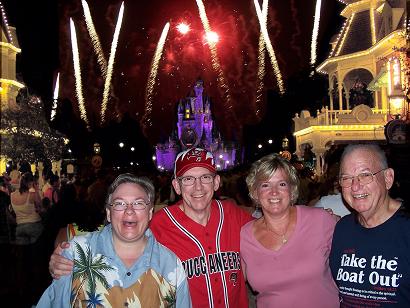
[Click on any photo to see original in various sizes]
... have in common with this photo of war damage to Beirut from Reuters?
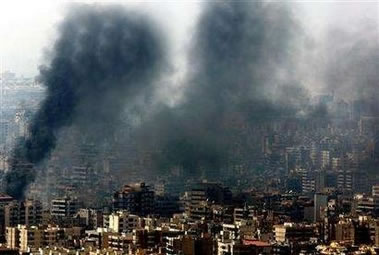
Answer: Both images are the result of clumsy manipulation using digital photo editing tools to alter the original appearance for effect. In my case I was faced with a difficult lighting situation where the foreground subjects (the Teleospouse, my brother, my sister and my dad, respecetively from left to right) were even more dimly lit than the background (the Main Street area in the Magic Kingdom) and I couldn't get a decent picture of both in the same shot, at least without spending more time tinkering with setting up the shot than is sane while vacationing at Disney World. So, I took an existing light shot of the scene and immediately took a flash shot with the idea that I would use the best bits of both. Here they are:
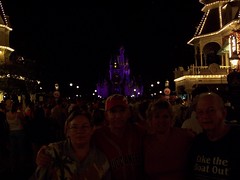
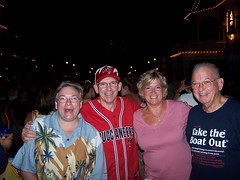
The shot without the flash is dark but contains usable images of the buildings along the street and of the castle in the background. The flash shot is well exposed (if slightly unkind) for the family members but the background is lost in the dark.
Here is the existing light shot adjusted to bring it out a bit -- lighter and a bit more saturated:
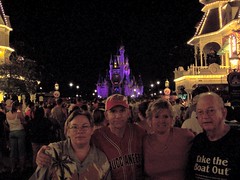
This is actually a fairly likable photograph. I had to lighten it so much that the faces of the subjects are starting to get blotchy and they are still too dark. The background details came out nicely, though.
Finally, since I didn't really ask the family members to stand with their backs to the fireworks while I took their picture we need one more shot for our composite:
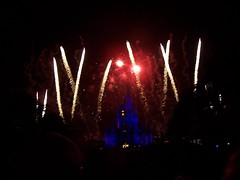
I assembled my composite by starting with the too-dark version of the existing light shot and then pasting this and that from the other shots over it. First, I grabbed the fireworks and pasted them in the sky in the background. Next I grabbed the castle and the buildings on the left and right of Mainstreet from the lightened existing light shot and pasted them over their too-dark versions. I had to tinker a bit with the smoke around the castle to keep the edges from showing too clearly. Finally, I grabbed the figures from the flash shot and pasted them in the foreground.
I am mildly happy wiht the result. The result looks professional, I think, but it does look manipulated. It looks a bit like a blue-screen, your-photo-on-a-tee-shirt "professional" photo one might have made in a mall. But, hey, it's Disney World and it's not about reality anyway.
Which brings us to the Reuters News Service photo which was supposed to be about reality. You can read about seventeen times as much as you need to know about all the clumsy ways the photo was manipulated in this story [Warning: photo of dead child] from the Little Green Footballs blog which is famous for exposing this sort of thing -- but you don't really need to. The photo just looks bogus because it is bogus. After a number of feeble excuses for the manipulation of the image Reuters wound up retracting the photo and firing the photographer. On the other hand, gentle reader, it is my sincere hope that you will not decide to fire me for my equally clumsy manipulations.
Reuters subsequently offered the following image as the unmanipulated 'original' of the retracted photo. A stickler might point out that the new photo has at least been cropped from another even-more-original shot since the manipulated image includes a few more buildings on the right-hand side. But news photos are almost always cropped, for reasons that will follow, so this probably doesn't matter.
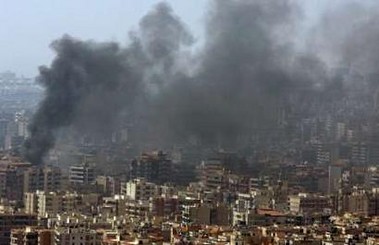
There is a difference between using photo editing software to create a family group photo where everyone has his or her eyes open and using it to create an alternate-universe Beirut where an Israeli airstrike left the city in rubble and oddly-textured smoke blackens the sky. There is a difference -- but it is not as easy to pin down as you might think.
Press photography has a long history of being at least half darkroom work. Before the advent of digital cameras a press photographer was expected to use fast film and a sharp, wide-angle lens. The image on the negative didn't need to look good; it just had to be there. While in the field the photographers job was to get the shot -- it didn't matter how it looked. Later, in the darkroom, there would be time for aesthetics. Dodging and burning and cropping were used to pick this or that bit off the negative and make it look as good as possible.
This process of 'improving' an image isn't necessarily dishonest, unless carried to extremes. Just about every would-be photographer, shortly after he or she picks up that first camera will see a beautiful sunset and take a photograph of it and, when it is printed, they will wonder what they thought they were photographing. They will pick up the print and think "Why did I take this? Was there a bird that flew off before I clicked the shutter?" Later, if they learn to use photo editing software they can tinker with the lightness, the contrast and the color saturation and find a way to put back that something that eluded the camera -- to produce an image that people react to the way the photographer reacted to the scene when the picture was taken.
Sometimes you don't need to do much. This image -- of me, dad and four of my nieces -- was very lightly manipulated -- just a little tinkering with the contrast and saturation to correct for the backlighting.
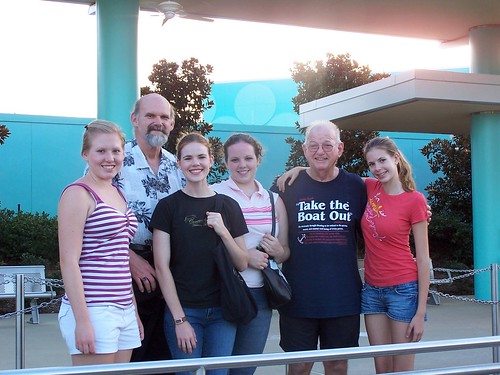
Sometimes you need to to more. This photo of my son on the Tomorrowland People Mover has been tweaked extensively. This image is barely salvagable. He was in the shade and the futuristic thingamabob I wanted in the background was in the bright sun. In the unmanipulated original he appears as a silhouette. I should have used a fill flash but, since I had exactly half a second to set up the shot it didn't happen. I've lightened and resaturated the shadow areas as much as I could but I can only do so much.

Actually, he has a better camera than mine (see below) and better editing software -- or at least, a more expensive camera and more pricy software. He is a graphic design student and he can justify such things as tools for his trade whereas I must budget them as toys for my toybox.
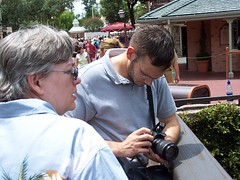
On the other hand, he is a full-time student, has a girlfriend and three part-time jobs and he has no time to tinker with his photos.
Using the same line of argument you can argue for making composites of group photos to eliminate subjects that had their eyes closed. People blink constantly but the percentage of the time their eyes are closed is quite small and we tend to ignore it. Sadly, we haven't taught a camera to ignore it and in any large group photo there is bound to be someone caught in mid-blink. That's not what the photographer saw when he snapped the photo but thats what the camera got. A well-assembled composite that replaces the blinkers with images from a second or two later is a much more accurate recording of the scene.
This photo (which I ran before in teleoscope: Motts Reunions) is such a composite.
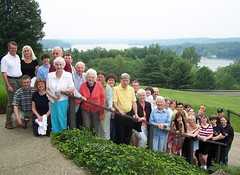
Building composites is the point, I think, where a news photographer has gone too far. The same photographer who produced the manipulated photo of Beirut also took the famous photograph of a "rescue worker" holding up the body of a child pulled from a building destroyed by an Israeli air strike. If you look closely at that photo it is fairly clear that he edited the photo to emphasize the color of the blue plastic pacifier pinned to the child's shirt. That represents a bit of editorializing on the part of the photographer but is probably fair. The fact that the same "rescue worker" appears in dozens of similar photos suggests that the events were staged for the camera which is more quesionable. But with the Beirut image he had clearly crossed the line -- not only adding more smoke but actually adding additional buildings to the damaged area.
To a certain extent what one thinks of such manipulation depends on what one thinks of the motivation of the manipulator. I tinker with my photos to make up for my shortcomings as a photographer and also to present my friends and family in the best possible light. The photographer sacked by Reuters was trying to produce photographs that would appeal to the mildly anti-American and fashionably antisemitic photo editors of his news organization.
Once one starts tinkering it is hard to stop. I may not be done with the photos I have included here. It is tempting, for instance, for me to substitute a different image of the Teleospouse in my composite since the flash caught her while she was saying something funny and it made her look retarded. She actually doesn't generally look like that so a bit more tinkering might be justified. I might try using part of the photo below -- a more carefully posed (and, yes, deliberate) shot taken in line for the Buzz Lightyear ride in Tomorrowland.
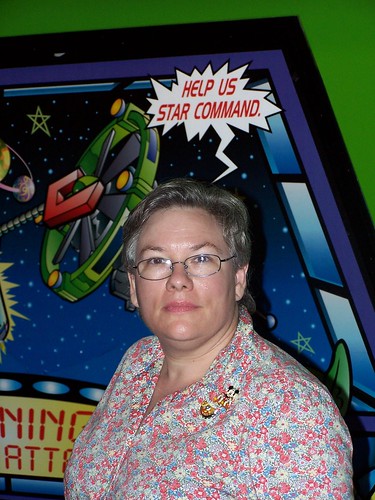

No comments:
Post a Comment